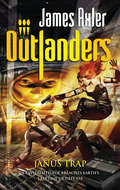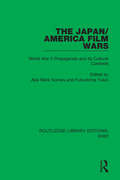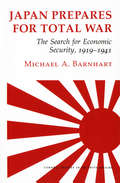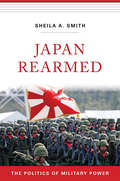- Table View
- List View
James VI and I: Collected Essays by Jenny Wormald
by Jenny WormaldThe renowned historian Jenny Wormald was a ground-breaking expert on early modern Scottish history, especially Stewart kingship, noble power and wider society. She was most controversial in her book-length critique of Mary, Queen of Scots. Unfortunately, Jenny never got round to producing a similar monograph on a monarch she was infinitely more fond of, King James VI and I, before her untimely death in 2015.In the absence of such a book, this volume brings together all the major essays by Jenny on James. She wrote on almost every aspect and every major event of James' reign, from the famous Gunpowder Plot, the Plantation of Ulster, the Gowrie Conspiracy, to the witchcraft panics, as well as James' extensive writings. She wrote extensively on James' Scottish rule, but she was also keenly interested in James as the first king of all of Britain, and many of her essays unpick the issues surrounding the Union of the Crowns and James' rule over all three of his kingdoms.This book is an invaluable resource for any scholar on this crucial time in the history of the British Isles.
Jamestown 1622: The Anglo-Powhatan Wars (Campaign #401)
by Cameron ColbyA dramatic illustrated exploration of the infamous massacre of 1622, and the events of a pivotal conflict in colonial American history. Since 1607, English settlers of Jamestown maintained a shaky relationship with the Powhatan Confederacy. As the Virginians expanded their profitable tobacco fields, bolstered by new settlers each year, the Powhatan tribes grew wary of English power. In 1622, Chief Opechancanough shattered the peace with a surprise attack on the Jamestown settlements, an attack in which 347 English settlers, one-third of the Virginia colony, were killed in a single day. Opechancanough hoped to eliminate the European presence with a decisive blow, but instead began a decade-long war with Jamestown.In this engaging and expertly researched work, Cameron Colby narrates the tumultuous events of Jamestown's early years. The first and second Anglo-Powhatan wars are brought vividly to life using battlescene artworks and period images. Detailed maps and 3D diagrams illustrate Native American and English tactics from 1607–34, and chart the progress of Jamestown's expansion as English settlers sought to drive back the Powhatan tribes of the Chesapeake.
Jamestown 1622: The Anglo-Powhatan Wars (Campaign #401)
by Cameron ColbyA dramatic illustrated exploration of the infamous massacre of 1622, and the events of a pivotal conflict in colonial American history. Since 1607, English settlers of Jamestown maintained a shaky relationship with the Powhatan Confederacy. As the Virginians expanded their profitable tobacco fields, bolstered by new settlers each year, the Powhatan tribes grew wary of English power. In 1622, Chief Opechancanough shattered the peace with a surprise attack on the Jamestown settlements, an attack in which 347 English settlers, one-third of the Virginia colony, were killed in a single day. Opechancanough hoped to eliminate the European presence with a decisive blow, but instead began a decade-long war with Jamestown.In this engaging and expertly researched work, Cameron Colby narrates the tumultuous events of Jamestown's early years. The first and second Anglo-Powhatan wars are brought vividly to life using battlescene artworks and period images. Detailed maps and 3D diagrams illustrate Native American and English tactics from 1607–34, and chart the progress of Jamestown's expansion as English settlers sought to drive back the Powhatan tribes of the Chesapeake.
The Jane Austen Society: A Novel
by Natalie Jenner'A wonderful book, a wonderful read' Karen Joy Fowler, bestselling author of The Jane Austen Book Club'Hope can sometimes be just enough.'It's only a few months since the war ended but the little village of Chawton is about to be hit by another devastating blow. The heart of the community and site of Jane Austen's cherished former home, Chawton estate is in danger of being sold to the highest bidder.Eight villagers are brought together by their love for the famous author's novels, to create The Jane Austen Society. As new friendships form and the pain of the past begins to heal, surely they can find a way to preserve Austen's legacy before it is too late? And there may even be a few unexpected surprises along the way...A heartbreaking and uplifting novel of hope, loss and love. Perfect for fans of Miss Austen by Gill Hornby and The Guernsey Literary and Potato Peel Pie Society by Annie Barrows and Mary Ann Shaffer
Janus Trap
by James AxlerThe quest for Earth's domination remains the primary directive of an ancient, inhuman enemy. Challenging this alien bid for iron rule, an elite force led by former magistrates wages war against Earth's enslavers. These rebel commandos are resourceful, dedicated and possess the immutable human willpower to survive–by any means necessary….
Japan 1944–45: LeMay’s B-29 strategic bombing campaign (Air Campaign #9)
by Paul Wright Mark Lardas Adam Tooby Bounford.com Bounford.com Paul KimeThe air campaign that incinerated Japan's cities was the first and only time that independent air power has won a war.As the United States pushed Imperial Japan back towards Tokyo Bay, the US Army Air Force deployed the first of a new bomber to the theater. The B-29 Superfortress was complex, troubled, and hugely advanced. It was the most expensive weapons system of the war, and formidably capable. But at the time, no strategic bombing campaign had ever brought about a nation's surrender. Not only that, but Japan was half a world away, and the US had no airfields even within the extraordinary range of the B-29. This analysis explains why the B-29s struggled at first, and how General LeMay devised radical and devastating tactics that began to systematically incinerate Japanese cities and industries and eliminate its maritime trade with aerial mining. It explains how and why this campaign was so uniquely successful, and how gaps in Japan's defences contributed to the B-29s' success.
Japan 1944–45: LeMay’s B-29 strategic bombing campaign (Air Campaign #9)
by Paul Wright Mark Lardas Adam Tooby Bounford.com Bounford.com Paul KimeThe air campaign that incinerated Japan's cities was the first and only time that independent air power has won a war.As the United States pushed Imperial Japan back towards Tokyo Bay, the US Army Air Force deployed the first of a new bomber to the theater. The B-29 Superfortress was complex, troubled, and hugely advanced. It was the most expensive weapons system of the war, and formidably capable. But at the time, no strategic bombing campaign had ever brought about a nation's surrender. Not only that, but Japan was half a world away, and the US had no airfields even within the extraordinary range of the B-29. This analysis explains why the B-29s struggled at first, and how General LeMay devised radical and devastating tactics that began to systematically incinerate Japanese cities and industries and eliminate its maritime trade with aerial mining. It explains how and why this campaign was so uniquely successful, and how gaps in Japan's defences contributed to the B-29s' success.
Japan 1945: From Operation Downfall to Hiroshima and Nagasaki (Campaign)
by John White Clayton ChunIn this 200th Campaign series title Clayton Chun examines the final stages of World War II as the Allies debated how to bring about the surrender of Japan. He details Operation Downfall (the planned invasion of the Japanese home islands).Chun explains why these plans were never implemented, before examining the horrific alternative to military invasion – the attacks on Hiroshima and Nagasaki with nuclear weapons. With a series of illustrations, including detailed diagrams of the atomic bombs, a depiction of the different stages of the explosions and maps of the original invasion plans, this book provides a unique perspective of a key event in world history.
Japan 1945: From Operation Downfall to Hiroshima and Nagasaki (Campaign #200)
by John White Clayton ChunALSO AVAILABLE TO BUY AS AN E-BOOK. In this 200th Campaign series title Clayton Chun examines the final stages of World War II as the Allies debated how to bring about the surrender of Japan. He details Operation Downfall (the planned invasion of the Japanese home islands).Chun explains why these plans were never implemented, before examining the horrific alternative to military invasion – the attacks on Hiroshima and Nagasaki with nuclear weapons. With a series of illustrations, including detailed diagrams of the atomic bombs, a depiction of the different stages of the explosions and maps of the original invasion plans, this book provides a unique perspective of a key event in world history.
The Japan/America Film Wars: World War II Propaganda and its Cultural Contexts (Routledge Library Editions: WW2 #15)
by Abé Mark Nornes and Fukushima YukioWith contributions from noted critics and film historians from both countries, this book, first published in 1994, examines some of the most innovative and disturbing propaganda ever created. It analyses the conflicting images of these films and their effectiveness in defining public perception of the enemy. It also offers pointed commentary on the power of visual imagery to enhance racial tensions and enforce both positive and negative stereotypes of the Other.
The Japan/America Film Wars: World War II Propaganda and its Cultural Contexts (Routledge Library Editions: WW2 #15)
by Abé Mark Nornes Fukushima YukioWith contributions from noted critics and film historians from both countries, this book, first published in 1994, examines some of the most innovative and disturbing propaganda ever created. It analyses the conflicting images of these films and their effectiveness in defining public perception of the enemy. It also offers pointed commentary on the power of visual imagery to enhance racial tensions and enforce both positive and negative stereotypes of the Other.
Japan and Reconciliation in Post-war Asia: The Murayama Statement and Its Implications
by Rwei-Ren WuTaking a comparative approach and bringing together perspectives from Japan, China, Korea, and Taiwan, this volume considers former Japanese prime minister Tomiichi Murayama's 1995 apology statement, the height of Japan's post-war apology, and examines its implications for memory, international relations, and reconciliation in Asia.
Japan and the Great War
by Antony Best Oliviero FrattolilloIn this book, seven internationally renowned experts on Japanese and Asian history have come together to investigate, with innovative methodological approaches, various aspects of the Japanese experience during and after the First World War.
Japan as (Anything but) Number One
by Jon WoronoffA full scale examination of the 1979 Sino-Vietnamese War - the events that led to it, the Cold War aftermath, and the implications for the region and beyond.
Japan as (Anything but) Number One
by Jon WoronoffA full scale examination of the 1979 Sino-Vietnamese War - the events that led to it, the Cold War aftermath, and the implications for the region and beyond.
Japan as the Occupier and the Occupied
by Christine De Matos Mark E. CaprioJapan as the Occupier and the Occupied examines transwar political, military and social transitions in Japan and various territories that it controlled, including Korea, Borneo, Singapore, Manchuria and China, before and after August 1945. This approach allows a more nuanced understanding of Japan's role as occupier and occupied to emerge.
Japan in the 1960s: Ten Years of Turning Points (Inside East Asia)
by Robert D. Eldridge Jason M. MorganEldridge and Morgan set a new paradigm for East Asian contemporary historiography by viewing the decade of the 1960s as hermeneutically powerful. From street battles over Japan’s security treaty with the United States, to a peace treaty with the former Japanese territory of South Korea, to Japan’s hosting the 1964 Summer Olympics, the 1960s in Japan was a decade of turning points. This book is the first to see the 1960s as a historical subject in its own right and argues that the specificity and internal complexity rooted in East Asia during this period showed how East Asians were dynamic agents in shaping the decade. In this volume, contributors consider Japanese responses to a 1961 coup in the Republic of Korea; the Satō Eisaku administration’s approach to nuclear deterrence and to the question of Okinawa’s return from American control; U.S.-Japan intellectual exchange during the Cold War; support by Japanese businesspeople for the Self-Defense Forces; the “soft power” of Japanese cinema in the 1960s; Japan’s understanding of 1960s United Nations peacekeeping operations; changes in “national polity” discourse in the 1960s; the Dalai Lama’s 1967 visit to Japan; economic development in and cultural exchange between 1960s Japan and Spain; Japan’s science and technology interactions with the United States; and the earliest known, and suspected, cases of North Korean abduction of Japanese citizens. Much of the information in this volume has never appeared in English before.This is an important volume for historians, political scientists, sociologists, and other scholars specializing in the twentieth century and those interested in cutting-edge history-writing about a transformative 10-year period in East Asia.
Japan in the 1960s: Ten Years of Turning Points (Inside East Asia)
Eldridge and Morgan set a new paradigm for East Asian contemporary historiography by viewing the decade of the 1960s as hermeneutically powerful. From street battles over Japan’s security treaty with the United States, to a peace treaty with the former Japanese territory of South Korea, to Japan’s hosting the 1964 Summer Olympics, the 1960s in Japan was a decade of turning points. This book is the first to see the 1960s as a historical subject in its own right and argues that the specificity and internal complexity rooted in East Asia during this period showed how East Asians were dynamic agents in shaping the decade. In this volume, contributors consider Japanese responses to a 1961 coup in the Republic of Korea; the Satō Eisaku administration’s approach to nuclear deterrence and to the question of Okinawa’s return from American control; U.S.-Japan intellectual exchange during the Cold War; support by Japanese businesspeople for the Self-Defense Forces; the “soft power” of Japanese cinema in the 1960s; Japan’s understanding of 1960s United Nations peacekeeping operations; changes in “national polity” discourse in the 1960s; the Dalai Lama’s 1967 visit to Japan; economic development in and cultural exchange between 1960s Japan and Spain; Japan’s science and technology interactions with the United States; and the earliest known, and suspected, cases of North Korean abduction of Japanese citizens. Much of the information in this volume has never appeared in English before.This is an important volume for historians, political scientists, sociologists, and other scholars specializing in the twentieth century and those interested in cutting-edge history-writing about a transformative 10-year period in East Asia.
Japan in the American Century
by Kenneth B. PyleNo nation was more deeply affected by America’s rise to power than Japan. The price paid to end the most intrusive reconstruction of a nation in modern history was a cold war alliance with the U.S. that ensured American dominance in the region. Kenneth Pyle offers a thoughtful history of this relationship at a time when the alliance is changing.
Japan, Italy and the Road to the Tripartite Alliance (Security, Conflict and Cooperation in the Contemporary World)
by Ken IshidaThis book employs a comparative approach to explore the decision-making processes behind the Japanese and Italian foreign policies concerned with East Asia, Africa, Europe and the Mediterranean. It explores these policies in relation to the Axis powers and Britain in the 1930s. Both Japan and Italy shared significant similarities in their decision-making processes, which help to illustrate the workings of ultra-nationalist and fascist foreign policy. The work examines the mechanism of decision-making in the foreign ministries, rather than the personalities of leaders, in order to understand why and how both countries finally chose unexpected partners. The Tripartite Alliance has often been perceived through the diplomatic motives and arbitrary manners of dictatorial leadership in Nazi Germany, Fascist Italy and ultra-nationalist Japan individually. This book compares the foreign policies of Italy and Japan and looks outwards to their diplomatic relations with Britain, a key imperial factor in their expansions into East Asia and Africa, contrasting these Axis powers with Germany, usually thought to typify fascist diplomacy.
Japan Prepares for Total War: The Search for Economic Security, 1919–1941 (Cornell Studies in Security Affairs)
by Michael A. BarnhartThe roots of Japan's aggressive, expansionist foreign policy have often been traced to its concern over acute economic vulnerability. Historian Michael Barnhart tests this assumption by examining the events leading up to World War II in the context of Japan's quest for economic security. Drawing on a wide array of Japanese and American sources, this is the first English-language book on the war's origins to be based on research in archives on both sides of the Pacific. Barnhart focuses on the critical years from 1938 to 1941 as he investigates the development of Japan's drive for national economic self-sufficiency and independence and the way in which this drive shaped its internal and external policies. He also explores American economic pressure on Tokyo and assesses its impact on Japan's foreign policy and domestic economy. He concludes that Japan's internal political dynamics, especially the bitter rivalry between its army and navy, played a far greater role in propelling the nation into war with the United States than did its economic condition or even pressure from Washington.Japan Prepares for Total War sheds new light on prewar Japan and confirms the opinions of those in Washington who advocated economic pressure against Japan. At a time of growing interest in U.S.-Japanese economic relations, this book will be stimulating and provocative reading for scholars and students of international relations and American and Asian history.
Japan Rearmed: The Politics of Military Power
by Sheila A. SmithModern Japan is not only responding to threats from North Korea and China but is also reevaluating its dependence on the United States, Sheila Smith shows. No longer convinced they can rely on Americans to defend their country, Tokyo’s political leaders are now confronting the possibility that they may need to prepare the nation’s military for war.
Japanese Armies 1868–1877: The Boshin War and Satsuma Rebellion (PDF)
by Gabriele EspositoThe restoration of the Meiji Imperial dynasty in 1868, after 250 years of the Tokugawa Shogunate, decisively opened Japan to the outside world and the monarchy embraced modernization, including the creation of a new Westernized army. However, this modernization process was resisted by the traditional Samurai feudal nobility, leading to a series of battles. The first clash between the two cultures came swiftly. During the Boshin War of 1868–69, a French military adviser, Jules Brunet, changed sides to join the insurgents. They won several engagements before the final crushing of the rebel Ezo Republic. After this point, the Imperial Army continued to modernize along French lines, and social changes began to impoverish Samurai noblemen, who lost their social and political role and their associated privileges.During 1876, the powerful Satsuma Domain, around Kagoshima in south-west Kyushu, became a focus for discontent. Its leader Saigo Takamori effectively ignored the central government, and in January 1877, increasing unrest broke out into open rebellion. The Imperial forces were now much stronger, and the Navy could land troops and bombard Kagoshima. The bitter Satsuma siege and attempted capture of Kumamoto Castle finally failed in April, and the Samurai made a last stand at Shiroyama on 24 September, choosing to go down fighting. This marked the final defeat and displacement of the Samurai class. This fully illustrated title explores the fall of the Samurai in detail, examining the arms, tactics, key figures of both sides, and charting the increasing Westernization of the Imperial forces.
Japanese Armies 1868–1877: The Boshin War and Satsuma Rebellion (Men-at-Arms)
by Gabriele EspositoThe restoration of the Meiji Imperial dynasty in 1868, after 250 years of the Tokugawa Shogunate, decisively opened Japan to the outside world and the monarchy embraced modernization, including the creation of a new Westernized army. However, this modernization process was resisted by the traditional Samurai feudal nobility, leading to a series of battles. The first clash between the two cultures came swiftly. During the Boshin War of 1868–69, a French military adviser, Jules Brunet, changed sides to join the insurgents. They won several engagements before the final crushing of the rebel Ezo Republic. After this point, the Imperial Army continued to modernize along French lines, and social changes began to impoverish Samurai noblemen, who lost their social and political role and their associated privileges.During 1876, the powerful Satsuma Domain, around Kagoshima in south-west Kyushu, became a focus for discontent. Its leader Saigo Takamori effectively ignored the central government, and in January 1877, increasing unrest broke out into open rebellion. The Imperial forces were now much stronger, and the Navy could land troops and bombard Kagoshima. The bitter Satsuma siege and attempted capture of Kumamoto Castle finally failed in April, and the Samurai made a last stand at Shiroyama on 24 September, choosing to go down fighting. This marked the final defeat and displacement of the Samurai class. This fully illustrated title explores the fall of the Samurai in detail, examining the arms, tactics, key figures of both sides, and charting the increasing Westernization of the Imperial forces.
Japanese Army Air Force Aces 1937–45 (Aircraft of the Aces)
by Henry Sakaida Grant RaceLittle has been published in English on the Japanese Army Air Force (JAAF), let alone its most successful fighter pilots no less than 150 of them achieved ace status during eight years of near-constant war, and they are all listed in this volume. From the arid plains of the Mongolian border region to the lush jungles of New Guinea, the JAAF was more than a match for the many opponents it fought against for control of the skies. Indeed, even when the mighty Allied war machine proved almost overwhelming from early 1944 onwards, the elite fighter pilots of the various sentais within the JAAF fought on with near-fanatical loyalty in defence of the Home Islands. Aircraft of the Aces 13 and 22 are also available in a single volume as 'Aces of the Rising Sun 1937-1945'.

















